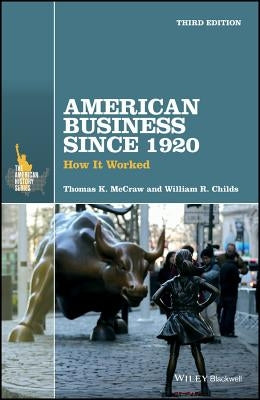Description
Tells the story of how America's biggest companies began, operated, and prospered post-World War I
This book takes the vantage point of people working within companies as they responded to constant change created by consumers and technology. It focuses on the entrepreneur, the firm, and the industry, by showing--from the inside--how businesses operated after 1920, while offering a good deal of Modern American social and cultural history. The case studies and contextual chapters provide an in-depth understanding of the evolution of American management over nearly 100 years.
American Business Since 1920: How It Worked presents historical struggles with decision making and the trend towards relative decentralization through stories of extraordinarily capable entrepreneurs and the organizations they led. It covers: Henry Ford and his competitor Alfred Sloan at General Motors during the 1920s; Neil McElroy at Procter & Gamble in the 1930s; Ferdinand Eberstadt at the government's Controlled Materials Plan during World War II; David Sarnoff at RCA in the 1950s and 1960s; and Ray Kroc and his McDonald's franchises in the late twentieth century and early twenty-first; and more. It also delves into such modern success stories as Amazon.com, eBay, and Google.
- Provides deep analysis of some of the most successful companies of the 20th century
- Contains topical chapters covering titans of the 2000s
- Part of Wiley-Blackwell's highly praised American History Series
American Business Since 1920: How It Worked is designed for use in both basic and advanced courses in American history, at the undergraduate and graduate levels.
Author: Thomas K. McCraw
Publisher: Wiley-Blackwell
Published: 01/26/2018
Pages: 407
Binding Type: Paperback
Weight: 1.00lbs
Size: 8.50h x 5.60w x 0.80d
ISBN13: 9781119097297
ISBN10: 1119097290
BISAC Categories:
- History | United States | General
- Business & Economics | Industries | General
About the Author
Thomas K. McCraw (d. 2012) was former Professor and Isidor Straus Professor of Business History for the Harvard Business School, where he was instrumental in making Business History an important aspect of the MBA program. McCraw received a Pulitzer Prize in History in 1985 for his book, Prophets of Regulation (1984). He also served as editor of the Business History Review, as associate editor of The Encyclopedia of the United States in the Twentieth Century, and as president and trustee of the Business History Conference. He was a member of the Board of Syndics of Harvard University Press, the Council of the Massachusetts Historical Society, the advisory board of Nomura School of Advanced Management (Tokyo), and the editorial boards of Reviews in American History and Harvard Business Review.
William R. Childs was former History Professor at Ohio State University. He retired from teaching in 2014. Tom McCraw was his advisor at The University of Texas at Austin in the 1970s. After McCraw left for the Harvard Business School in 1978, he remained on Childs' dissertation committee and hired him as a research assistant for his book Prophets of Regulation (1984). In addition to his two books and numerous articles and book reviews, Childs was editor of Essays in Economic and Business History (1995-1998) and has served on the Board of Editors for the Business History Review and Enterprise & Society.

